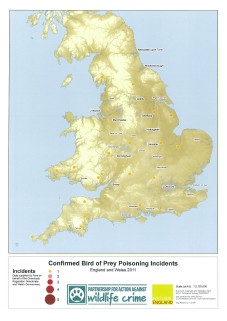12th February 2013
 Maps showing where birds of prey have been poisoned should serve as a wake-up call, Environment Minister Richard Benyon said today.
Maps showing where birds of prey have been poisoned should serve as a wake-up call, Environment Minister Richard Benyon said today.
The maps, published for the first time by the Partnership for Action Against Wildlife Crime (PAW), highlight both the number and location of confirmed poisonings of birds of prey from 2007 to 2011 across England and Wales.
Nineteen incidents of illegal poisonings occurred in 2011 bringing the total number of confirmed cases since 2007 to 101.
Environment Minister Richard Benyon said:
“I am appalled that these crimes continue to be committed and I am determined to stamp them out.
“Those responsible have no consideration for what they are killing or the impact their activities are having on wildlife and the wider environment.
“I want people to be alert to this problem and report their suspicions to the police. It is about time we put an end to this cruel and barbaric crime.”
The information published today also shows that the majority of poisonings were carried out using substances called Carbofuran, or aldicarb, which are illegal to possess in the UK and are potentially dangerous to humans.
Members of the public are warned not to touch any suspected poisoned animals or baits and to report them to their local police by calling 101.
At the same time, this targeted approach also protects the reputation of the many responsible land managers across England and Wales who do not tolerate crimes against birds of prey on their land.
 Robert Benson, Chairman of the Moorland Association added: “The Moorland Association condemns any act of wildlife crime and warmly welcomes the poisoning incident maps to help stamp out illegal poisoning of birds of prey.
Robert Benson, Chairman of the Moorland Association added: “The Moorland Association condemns any act of wildlife crime and warmly welcomes the poisoning incident maps to help stamp out illegal poisoning of birds of prey.
This targeted approach demonstrates that the vast majority of those living and working in the uplands of England and Wales respect the law with just two isolated incidents in the whole of these upland areas in 2011.
Interestingly, the Pennine Chain, the epicentre of grouse moor management, shows no incidents in 2011 and no clear ‘Hot Spots’ over the last five years, upholding the reputation of grouse moor managers. Banned pesticides have no place in grouse moor management and one incident is too many.
Birds of prey populations are at the highest levels since records began, and where our members have genuine problems with birds of prey impacting on other protected wildlife or legitimate land use, legal solutions can be available through licensing.”








